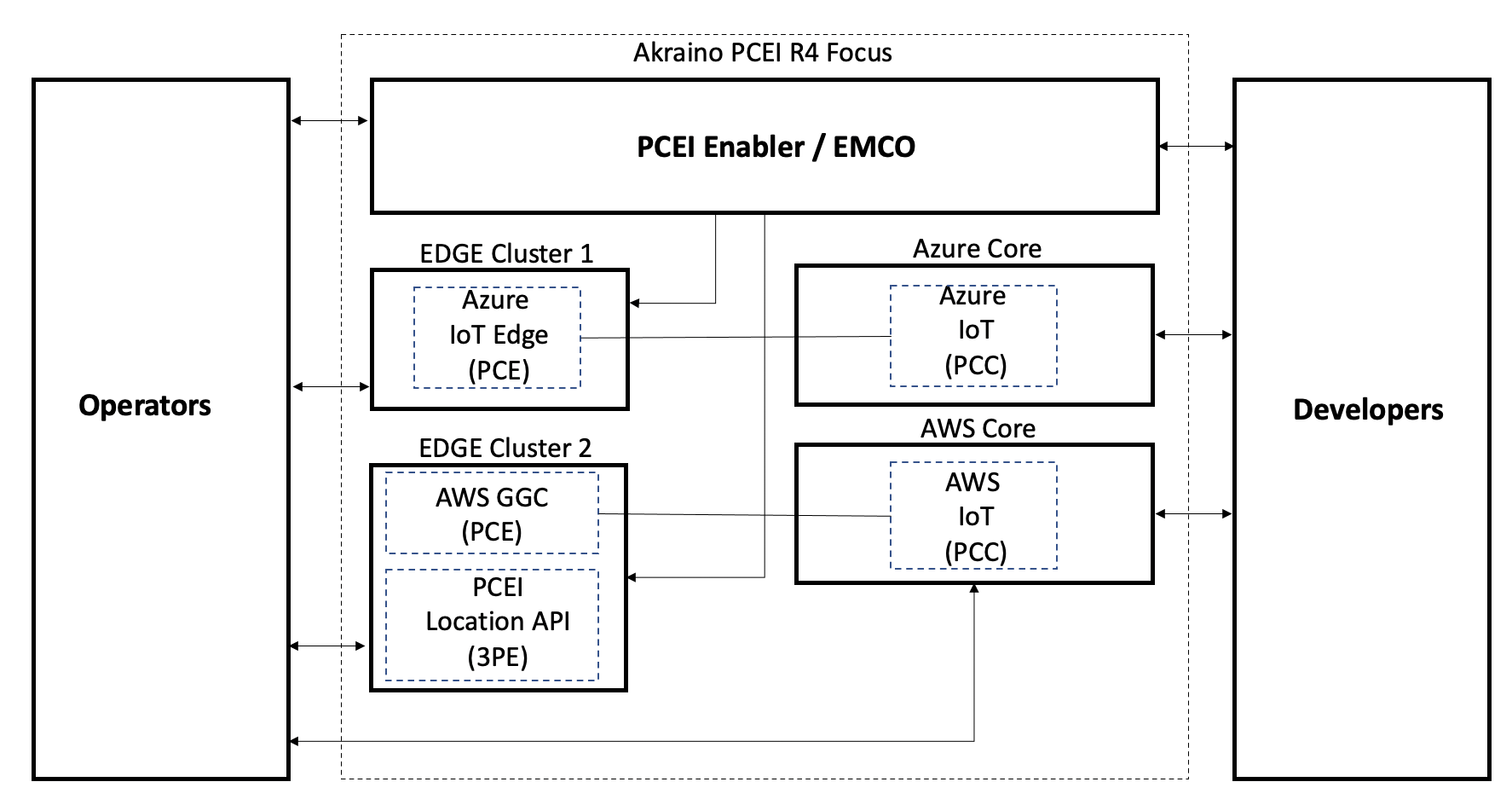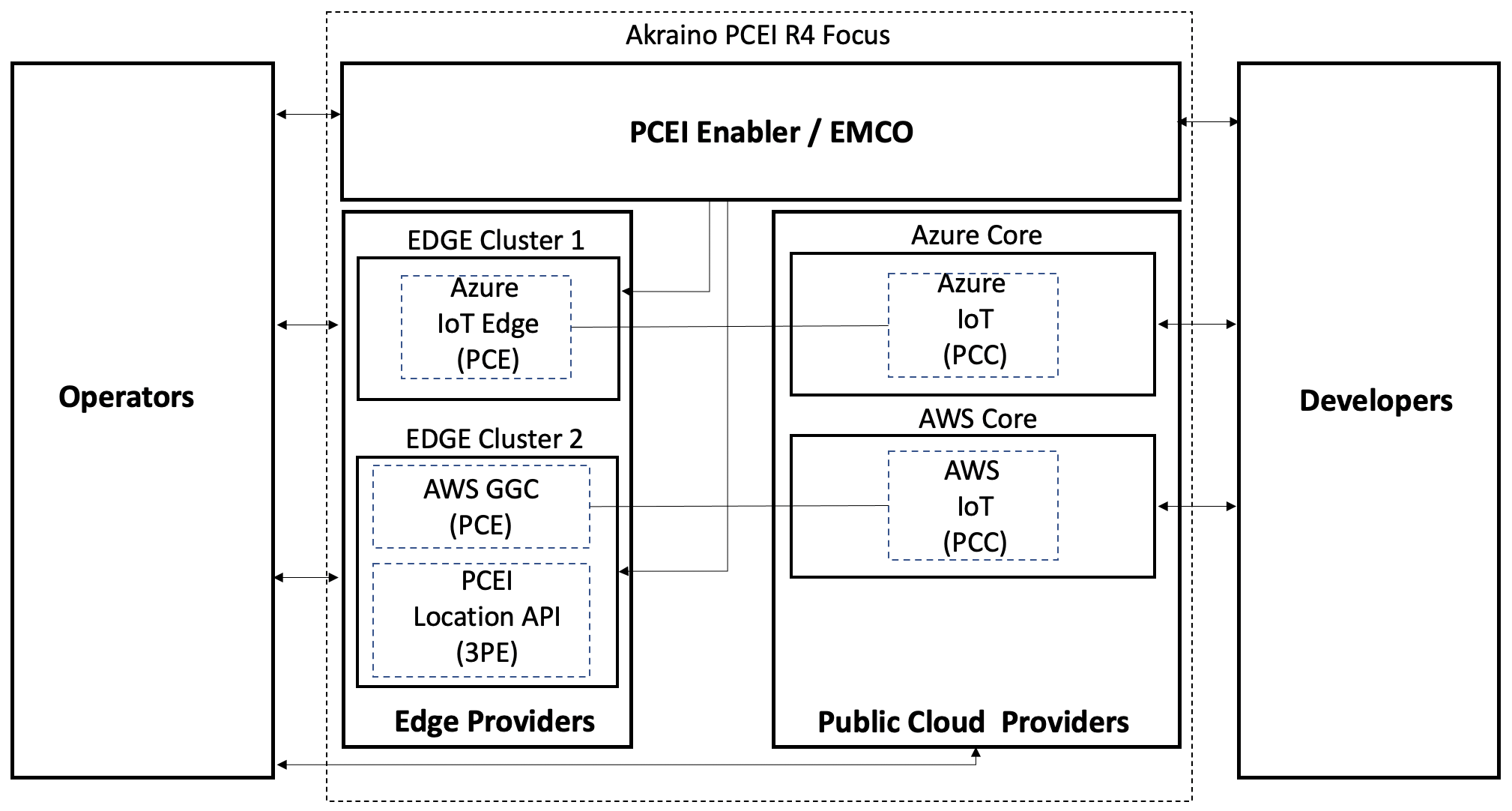...
This document describes the use of Public Cloud Edge Interface (PCEI) implemented based on Edge Multi-Cluster Orchestrator (EMCO) for deployment of Public Cloud Edge (PCE) Apps from multiple clouds (Azure and AWS), deployment of a 3rd-Party Edge (3PE) App (an implementation of ETSI MEC Location API App), as well as the end-to-end operation of the deployed PCE Apps using simulated Low Power Wide Area (LPWA) IoT client.
Functional Roles
Developers
Individuals/entities that:
- Create the PCE/3PE Apps
- Provision services in Public Clouds (PCC)
- Note that valid Public Cloud subscriptions/accounts are required
- Package PCE/3PE Apps using Helm Charts
- Access PCEI/EMCO Orchestrator using UI or APIs to onboard PCE/3PE services/apps
- PCEI R4 supports UI access only
Operators
Entities that:
- Provide network functions and services such as:
- Access (mobile or fixed)
- Network connectivity
- Devices (e.g. LPWA IoT)
- Access PCEI/EMCO Orchestrator using UI or APIs to deploy PCE/3PE apps
- Connecto to Edge Providers/Clusters and Public Clouds using Public Internet or Private Interconnect
- PCEI R4 supports Public Internet connectivity only
Edge Providers
Entities that:
- Provide edge infrastructure, such as:
- Edge Data Centers
- Edge Compute/Network/Storage hardware
- Edge Virtualization layer/software, such as Kubernetes, Openstack
- PCEI R4 supports Kubernetes only
- Provide Public Peering and Private Interconnection
- Between Operators and Edge Providers
- Between Operators and Public Clouds
- Between Edge Providers and Public Clouds
Public Cloud Providers
Entities that:
- Provide Iaas/SaaS services
PCEI Enabler
- Orchestration Software and APIs
- May be provided by:
- Operators
- Edge Providers
- Public Cloud Providers
End-to-End Validation Environment
...
Clone Azure IoT Edge from github:
NOTE: Due to Azure IoT Edge on K8S being in preview stage, please use the below URL to clone the Helm charts:
https://github.com/Azure/iotedge/tree/release/1.1-k8s-preview
| Code Block | ||
|---|---|---|
| ||
git clone https://github.com/Azure/iotedge cd iotedge/kubernetes/charts/ mkdir azureiotedge1 cp -a edge-kubernetes/. azureiotedge1/ cd azureiotedge1 ls -al total 24 drwxrwxr-x. 3 onaplab onaplab 79 Dec 24 13:14 . drwxrwxr-x. 5 onaplab onaplab 77 Dec 24 13:14 .. -rw-rw-r--. 1 onaplab onaplab 137 Dec 24 13:02 Chart.yaml -rw-rw-r--. 1 onaplab onaplab 333 Dec 24 13:02 .helmignore drwxrwxr-x. 2 onaplab onaplab 220 Dec 24 13:02 templates -rw-rw-r--. 1 onaplab onaplab 14226 Dec 24 13:02 values.yaml |
...
Click on "+ Add App" and add the "awsggc1" app. Make sure to use the "awsggc1" name to match the app tar file name without the extension:
// Oleg Berzin, is this figure same as the previous figure? - Tina Tsou
Define the AWS GGC app by adding the App tar filr and the Profile tar file:
...
| Code Block | ||
|---|---|---|
| ||
ssh onaplab@10.121.7.146
# Clone the PCEI repo
git clone "https://gerrit.akraino.org/r/pcei"
cd pcei/locationAPI/nodejs
# Build the Docker image
sudo docker build -f Dockerfile . -t pceilocapi:latest
#Run local Docker repository
sudo docker run -d -p 5000:5000 --restart=always --name registry registry:2
# Push the PCEI Location API image to local Docker repository:
sudo docker tag pceilocapi localhost:5000/pceilocapi
sudo docker push localhost:5000/pceilocapi |
...


